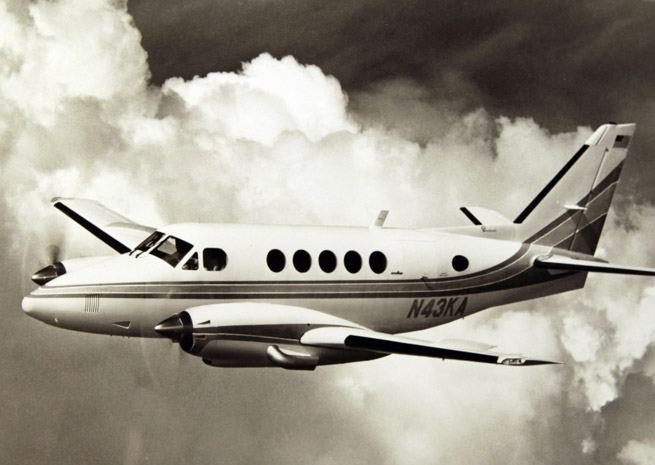Quick Look: King Air B100
A Plan B concept

As the proverb says, “Necessity is the mother of invention.” So when a mid-1970s strike at the Pratt & Whitney Canada factory halted delivery of PT6A engines to Beechcraft, the airframe manufacturer—which had been concerned about relying on a single powerplant supplier for its entire line of King Air twin turboprops—developed a Plan B: the Garrett TPE331-powered King Air B100.
The King Air 100 series was a stretched derivative of the Model 90, with a higher gross weight of 10,600 pounds. It used the wings, tail, and PT6A engines of the Beech 99 airliner and first flew in March 1969. A total of 89 King Air 100s was built before being superseded in 1972 by the Model A100, which featured a gross weight of 11,500 pounds, greater fuel capacity, and four-blade propellers. Some 157 A100s were built through 1979. The Garrett-powered B100 King Air, which first flew in March 1975, was introduced in 1976 and was produced alongside the A100 for several years.
The B100 cabin typically is configured with seven seats, including a belted lavatory seat, and has a baggage compartment located aft. Collins Pro Line avionics were offered as standard equipment on the B100, although some buyers opted for Bendix Gold Crown equipment. The cockpit also included a Sperry SPZ-200A autopilot and Sperry Primus 300 weather radar.
Although the B100 has the same fuselage as the A100 and the Super King Air 200, the B100 had a higher gross weight (11,800 pounds) than the A100 and offers some modest performance advantages over its Pratt & Whitney-powered counterpart. Initially, the TPE331-6 was not as reliable as the PT6; however, Garrett’s successor companies—AlliedSignal and Honeywell—have markedly improved the engine since its introduction.
Some B100 operators who wanted better hot-and-high climb and cruise performance have had their TPE331-6 engines converted to the -10 standard by National Flight Services, which also can install McCauley five-blade props, cabin soundproofing, and winglets on the aircraft.
Raisbeck Engineering also offers a number of performance-enhancing mods for the B100, including dual aft-body strakes, which reduce drag and noise; high-flotation landing gear doors, which improve climb and cruise performance and protect wheel wells, tires and brakes from the elements; and nacelle wing lockers, which provide more baggage space while reducing drag.
Lakeland, Florida-based Executive Wings has partnered with McCauley Propeller to offer the five-blade Blackmac propeller upgrade for the B100, which reduces cabin noise, increases climb rates, and includes a state-of-the-art deice system. Most recently, some B100 operators have retrofitted their aircraft with Garmin avionics.
The B100 compares favorably to the A100 and contemporary turboprops produced by other manufacturers, but the success of the King Air 200 led to the end of production in 1983, after 137 B100s had been delivered. Approximately 120 remain in service, about 100 of which are on the U.S. registry. According to Vref, B100 prices range from $450,000 for a 1976 model to $590,000 for a 1983 model.
Robert A. Searles is an aviation writer and editor.
Spec Sheet
King Air B100
Engines | Two Honeywell TPE331-6-252B engines at 715 shaft horsepower each
Seats | one or two pilots and six-10 passengers
Max takeoff weight | 11,800 lbs
Max cruise speed | 265 kts
Takeoff distance | 1,898 ft
Landing distance | 1,290 ft
Range | 1,120 nm
Wingspan | 45 ft, 11 in
Length | 39 ft, 11 in
Height | 15 ft, 5 in


